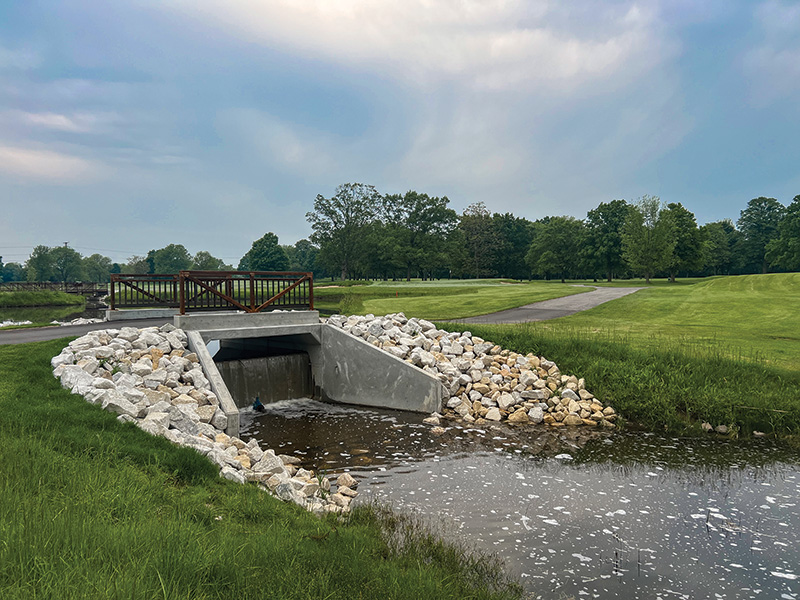
One of The Wisconsin Country Club's new dams. Photos by Adam Suelflow
Sometimes, the first step in resolving a dam problem comes from acknowledging you have a dam problem.
In the case of Adam Suelflow, CGCS, superintendent at The Wisconsin Country Club and 14-year association member, he knew he was walking into a dam problem.
In 2018, the year before Suelflow landed at TWCC, the suburban Milwaukee club had put in a new pump station. In the permitting process with the Wisconsin Department of Natural Resources, the crew learned there was an issue with the three dams on property.
“DNR said, ‘Hey, you’ve got three dams we don’t have any records of,’” Suelflow says, “so we started working with DNR to retroactively permit those existing dams.”
As part of that process, engineers were brought in to drain down the areas of Lincoln Creek around those dams and determine their soundness. As it turned out, those dams weren’t doing their dam job. They were deteriorating and allowing water to leak below and through them.
“At the end of the day, we had to either remove or replace all three structures,” Suelflow says. “They were all sized appropriately, but at that point, they were 40, 50 years old. They just needed to be redone.”
Suelflow knew a $1 million project to replace the structures would be a tough sell to the membership, but Concert Golf Partners bought the facility in 2023, and part of that transaction helped pay for the new dams, as well as bridges that also needed replacing.
“My pitch during the whole project was, ‘Hey, this isn’t a pretty project to spend a million dollars on, but it needs to be done,’” Suelflow says. “I’m fortunate to be able to see it through.”
In the process, TWCC added to its environmental cred.
Lincoln Creek is an urban waterway that feeds into the Milwaukee River, which feeds into Lake Michigan, which sits about 5 miles to TWCC’s east (the river empties into Lake Michigan in downtown Milwaukee, about 10 miles southeast of the course). That relatively short run makes any opportunity to filter that largely urban-runoff water critical, and golf courses are proven natural large-scale bio-filters.
And Suelflow has the numbers to prove it.
“The flow hasn’t necessarily changed from where it enters to where it leaves,” he says, “but the main benefit is filtration. It allows a lot of that debris and contaminants from the street to settle out.”

Removing an old dam at The Wisconsin Country Club
Suelflow reports water testing has shown nitrate levels dropped from 0.76 parts per million at the entry to the golf course to less than 0.1 ppm at the exit. Dissolved orthophosphates have dropped from 0.051 milligrams per liter at the entry to 0.016 mg/L at the exit.
“We act as a retaining pond, allowing those minerals to settle out,” Suelflow says. “Depending on the time of year, we’ve seen varying degrees of improvement, but it’s always better.”
TWCC has discovered another benefit with its new dams. Two of the three old structures had lost their functionality, but now the club can open the valves in the new dams to lower pond levels in anticipation of normal rain events. That was no help when the course was deluged with 14 inches of rain overnight in August, but now the course can weather typical 1-to-2-inch rain events with no flooding.
Suelflow sees the project, which was coordinated with Design2Construct, raSmith and Wondra Construction, with oversight from the DNR and City of Milwaukee, as a prime example of a golf course being a good environmental partner to the community in which it’s located.
To that end, he hopes to use the dam project as an in with nearby legislators, whom he intends to host in his role as a part of GCSAA’s Grassroots Ambassador program.
“I’ve struggled to get time with our representative’s office,” Suelflow says. “I’m using this as my foot in the door, just to show that the stigma there is with golf courses isn’t always the case.”
Andrew Hartsock is GCM’s editor-in-chief.